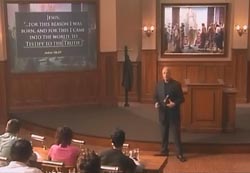 Though they’ll never admit it, most evolutionists adhere to evolution as followers in any other religion adhere to their faith. Though they’ll never admit it, most evolutionists adhere to evolution as followers in any other religion adhere to their faith.
|
||||
| In what was intended to be the first article I posted on this site – What is Rational Faith, Part 11 – I mentioned that those who believe in the godless theory of Evolution (which includes most atheists and materialistic scientists) – adhere to it as one adheres to and follows a religious faith. In other words it has taken on the significance of religion in their lives. Most evolutionists would deny this, as would atheists who think that because they define their atheism as a lack of faith/belief in God, they therefore think themselves immune to the common banalities (as they might describe it) of being a follower of a faith. Yet when you look at the impact of evolution on their lives, and how it changes their thoughts and behaviors, one can only conclude that for those who thoroughly understand the theory, it has taken the place of God in their lives2. Now you’ll note I’ve qualified the statement by the phrase “those who thoroughly understand the theory.” I do so to distinguish the true adherents from those who follow it without thinking because it’s the “in” thing to do; it’s the majority belief, and they don’t want to be out of the main stream or worse – appear ignorant, or as John C. Lennox puts it, they
Those who know little about evolution apart from the fact that it supposedly tells us where we came from and it’s what scientists believe, should read articles like Reclaiming The Intellectual and Moral High Ground – which will inform them both on claims made regarding evolution – and why they’re incorrect. If they still believe in evolution, then they appear to have a faith commitment as do other adherents to the Evolutionary faith. So now that we understand about whom I’m speaking the question becomes how can I defend such a claim? Simply – by the fact that those believe in evolution exhibit the same signs and behaviors as those who follow any other religious faith. As the saying goes, if it looks like a duck, and walks like a duck, a quacks like a duck – it’s probably a duck. There are a number of such tell tale signs, let me just give you a few off the top of my head: Continue Reading |
Category Archives: Bible
Time to End the In House Debate
 Among Christians there should be no questions or debates about the origins of life, the earth or the universe. |
||||
|
– How important is this for Christians to deal with? Dr. Danny Faulkner, Author, Distinguished Professor Emeritus, retired and now on staff with Answers in Genesis and its Creation Museum responded:
True, but Dr. Faulkner misses the elephant in the room. Dr. Hugh Ross, Astronomer and best-selling author responded:
Dr. Ross’ answer not only misses the elephant in the room, but it is also very misleading. Why do the biblical creeds not mention the time of creation? (More importantly the duration.) Because that is not one of the issues they were dealing with at the time. In the first few centuries after Christ’s resurrection, the church was besieged with Christological issues – docetism (Christ only seemed to have a body but was really just spiritual), gnosticism (a whole range of errors regarding God from which we get the phrase “children of a lesser god”; errors regarding Christ; and the nature of good and evil), monophysitism (Christ had only one nature), and so on. So they were concerned with clearly and correctly defining who Christ was – that he was “very God from very God” (from the Nicene Creed) and “one person with two natures” (From the Definition of Chalcedon). The Nicene Creed was written in 325 AD; the definition of Chalcedon was written in 451. The issue of the length of creation didn’t come up until needed for evolution, and Darwin didn’t publish “Origin of Species” until 1859. So of course the creeds don’t deal with that. Dr. Ross also states big bang cosmology identifies the who of creation as the God of the Bible. Really? Perhaps he should tell that to Continue Reading |
A Resurrection Day Response

I was asked by multiple atheists – what if some other religious book were true? Here is the response.
In the song “Nada One” Heart’s Nancy Wilson sings about an ephemeral, nocturnal love who has glowing, night creature eyes that frequents her dreams. This mysterious love seems to appear only in dreams where no one can see him. For even when wandering through streets, she describes this scene:
With such descriptions, one questions the reality of his existence. Indeed she herself seems to harbor a doubt or two since she must reminder herself “you are as real as I feel.” The one thing that’s not mysterious in this song, is what she means by “nada one.” Clearly “nada one” is a play on the sound of the phrase “not a one,” yet still, one must wonder – since it is always capitalized – if she’s using it as a proper noun – speaking or referring to a being named “Nada One.” The Wilson sisters were purposefully ambiguous for artistic purposes. But as we’ll see God is purposefully clear and unambiguous to eliminate doubt and nurture faith. I was reminded of this song as I awaited responses to a question I had posed. Let me step back and explain. I saw the below tweet that informed people that last Thursday was “National Ask an Atheist Day.”
This seemed like a perfect opportunity to re-query the unbelieving regarding a question I had asked in a Continue Reading |
Atheists – too afraid to answer
 Some Atheists are too afraid to answer the difficult questions. |
||||
|
There’s a very good article by Peter Saunders titled Twenty questions Atheists struggle to Answer: How Theism does better on the first six. Before presenting the first six issues which atheists struggle to answer (actually he’s being kind – he uses “struggle” as if they have an answer when actually atheism has no reasonable answer to the first 6.), he makes some preliminary comments. The third comment he makes – actually a challenge – is particularly apropos to a recent discussion I had. Speaking to Atheists and agnostics, Saunders says:
Of particular interest is the second sentence, a description of the toxic environment often created by atheists in their so called “discussions” with Christians or theists – discussions which are for the atheist often little more than opportunities to mock. To the list of the usual allegations I would add the allegation of “fallacious argument” a claim atheists wield as a shield against anyone who doesn’t agree with them – apparently before even reading the argument because they use it even when it doesn’t apply. Case in point, my last article – an article which ended with a hypothetical question along the lines of Pascal’s wager: Continue Reading |
A question of authority
What will it take for you to believe? Charlton Heston as Moses – “You are not worthy to receive these commandments” |
||||
|
Twitter is of course home to many ongoing debates, one of which is the ongoing debate between atheists and theists; creationists and materialists – those who adhere to the standard non-supernatural theories of origins for the universe and life. One such debate was brought to my attention with the following tweet:
To the contrary:
This directly contradicts the contention that all fossils are “arranged in evolutionary order”. In fact the situation is worse than that when one considers Continue Reading |
Reclaiming the Intellectual and Moral high ground
Don’t fall prey to logical traps, old arguments, or the emotional baiting of evolutionists.
 “It’s over Anakin, I have the high ground.” |
||||
| In my previous post I referenced an article titled “The Top 10 Signs that You Don’t Understand Evolution at All” which is really a restatement of objections that evolutionists believe they have adequately answered, while at the same time lightly(?) mocking creationists – as evolutionists are wont to do. (Whether lightly or not I’ll leave to you.) As is typical in a list like this, the more important questions (for which they have no answer) are not even mentioned much less given adequate answers to. But since I couldn’t bear the thought of leaving you hanging without the answers having myself referenced the article, here are responses to show none of these issues are problems for rational thinking Christians. A word of warning before we begin: Since he couches many of these statements in broad universals (“never,” “always,” etc. – which is a dead give away that the statement is almost certainly untrue and a good candidate for the “all or nothing” logical fallacy); it follows that the position he’s trying to ridicule may be technically untrue, but the point beneath the ridicule that he’s trying to make has been thoroughly refuted as I note below. Below in bold is Tyler Francke’s list of “The top 10 signs that you don’t understand evolution at all” with my explanations following immediately; and so there is no mistake on who’s saying what, my comments are indicated by my initials.
DC>He makes a number of questionable statements here, I’ll just point out a couple. First he notes:
DC>Evolution of the type we’re talking about – molecules to man is not observable. Like many evolutionists he is committing the logical error of equivocation – using the term evolution in more than one sense (which is commonly done to win arguments, though it’s logically fallacious). Natural selection (which is not evolution) is observable; molecules to man evolution is not. Second, he goes on to talk about an inference to the best explanation (which I drew upon in my last article) but intelligent design theorists and creationists alike, (not to mention scientists who dissent from evolutionary theory) would say given the evidence, such as the fossil evidence below, he has not drawn an inference to the best explanation by believing it points to evolution. He states:
DC>I would challenge him that it is not the evidence that points him to evolution, it’s his a priori beliefs (science is authoritative over scripture) that lead him to the conclusion that evolution is true because judging by evidence alone, (such as the evidence from DNA, the young solar system, etc.) the correct conclusion is that there was an intelligent designer. 2. You think we’ve never found a transitional fossil. DC>This is frankly very misleading. A more precise statement would be Continue Reading |
The Best Reason for Apologetics

As you might imagine of one hosting a website that deals with apologetic issues, I listened with interest to the debate last Saturday on Moody’s Up For Debate entitled “Do Apologetics Help or Hurt our Christian Witness?” As always the host, Julie Roys welcomed well qualified guests for the discussion: author and professor David Fitch and author and professor Nancy Pearcey. Dr. Fitch offered the concern that apologetics train us in a posture of defensiveness; and that we don’t listen as well, having answers ready before we hear the question. His main objection is summarized in this tweet:
We have a posture of defensiveness which is not needed. Rather we need to embody the story God is telling through us. – #DavidFitch
— Up for Debate Radio (@Up4DebateRadio) March 8, 2014
Professor Pearcey had a number of good responses, in addition to her own testimony of how apologetics helped her come to the faith, some of her reminders include:
– We need to be inclusive in our approaches
– We should use all the tools available to us
– It is possible to do apologetics wrong (implied: therefore learn to do it right!)
– Apologetics can descend into a game of “gotcha”
– And as she reminded us in this tweet:
#Apologetics assists in making ones understanding not simply emotional but intellectually. – #NancyPearcey
— Up for Debate Radio (@Up4DebateRadio) March 8, 2014
But the answer I was expecting, Continue Reading
What is Rational Faith? Part 2
 The 19th century classic “Flatland” by Edwin A. Abbott is an allegory of the resulting social problems and intellectual impasse that results when a person who has been enlightened (and sees a truth beyond what’s normally possible in the physical realm) tries to present that truth to the unenlightened. Flatland is so named because it, and all its inhabitants live in a two dimensional world. When a 3 dimensional object – a being in the shape of a sphere – is introduced to a 2 dimensional Flatlander – a mathematician – the response of humans to revelations (by way of analogy) is on display.
The 19th century classic “Flatland” by Edwin A. Abbott is an allegory of the resulting social problems and intellectual impasse that results when a person who has been enlightened (and sees a truth beyond what’s normally possible in the physical realm) tries to present that truth to the unenlightened. Flatland is so named because it, and all its inhabitants live in a two dimensional world. When a 3 dimensional object – a being in the shape of a sphere – is introduced to a 2 dimensional Flatlander – a mathematician – the response of humans to revelations (by way of analogy) is on display.
As you might expect, the mathematician has the all the concepts and mathematical knowledge to understand the description of a sphere, but while he understands technically what the sphere is saying, since a 3 dimensional object is outside of the realm of the possible within a 2 dimension world, he has a hard time believing what the sphere is saying is true – until the sphere performs miracles – that is to say feats that are miraculous to the two dimensional characters of the story, yet totally understandable to a 3 dimensional person (such as the reader). The main conflict of story centers around the beliefs of most flatlanders: since – as far as they are concerned – 3 dimensional objects are impossible and don’t exist, anyone who claims they are possible (or has seen one) is either insane or dangerous or both, and thus must be placed permanently in a mental institution or must be put to death. Without delving any further into the story, let me point out what Abbott so masterfully illustrates using concepts that we, as 3 dimensional beings, readily understand by his analogy: Continue Reading
Windtalkers and DNA
 |
DNA – a highly complex very efficient information storage and retrieval system |
In the 2002 movie “Windtalkers”, Sergeant Joe Enders, played by Nicholas Cage is given this charge: “Protect the code.” It’s World War II and the Marines are using the code for critical tactical communications that they cannot afford to have intercepted. They’ve developed a unique code that proves to be unbreakable. That’s because it’s double coded.
According to this Wikipedia article, in a moment of luck mixed with a touch of genius reminiscent of the insight highlighted in “A Beautiful Mind”, Captain Lawrence of the U.S. Army overheard two men speaking in the Choctaw native American language – and had an inspiration for the code. The article gives further details on the “Code Talkers” but the point I want to make is this: The communication employed by the Marines was coded. Coded information always requires someone – an intelligence – to create the code. If that is not obvious, this particular case clarifies things because the communication is double coded – which highlights the intelligence required. It’s quite obvious that there is no process in the universe that can create double coded information without an intelligence behind it.
Consider the complexity of creating and decoding a double coded message. Suppose the word they wanted to communicate was “Plateau”. Plateau may be coded (in English) to the word “horse”. “Horse” would then be translated into the word used in the Choctaw language for horse, which is issuba.1 The process looks something like this:
Plateau > Code word: Horse >Horse re-coded : issuba
Notice the process of mapping meaning to a symbol that takes place. It’s clear to see why this code was unbreakable. Even if they could catch the syllables of the Choctaw words which were spoken (which would have been difficult enough) – the enemy wouldn’t know what those syllables “is-su-ba” meant. Let’s say the enemy managed to catch the word, they next have to determine the convention used. It’s not English, French, Spanish, etc. They need to figure out the language convention: Choctaw. If they manage to figure that, they additionally need to find someone who speaks Choctaw. If you do, you now have the meaning of the word in Choctaw – “horse” but you still haven’t intercepted the message, because the message is still in code. “Horse” isn’t the message, “horse” must be again decoded by an intelligence to retrieve the originally intended message using yet another code. And for that you must have the code. And I’ll say it again because it’s a critical point: Codes are not created by random processes, they are the result of an intelligence. Intelligence is required to create a code, to encode a message, and to create a process to decode the message.
Clearly coded messages require intelligence. Both to encode and decode. But in fact the need for intelligence goes beyond that. The coder must use a system of pre-defined symbols as the medium by which the coded message is transferred or carried. (And if one does not exist, the communicator must create such a system.) For example on this web page, the system employed is the specially formed black marks called “letters” used to represent small units of meaning that represent sound. The letters are then formed into a concept by arranging them in the pre-selected units of the code or language, in this case English words. Once the concepts are encoded into words, an intelligence must further arrange the words to communicate something even more complex: a complete message – a phrase conveying meaning. Consider this string of letters and characters:
lb)rah ured(e sy(eir)
It has what appears to be letters arranged into words, but it is meaningless. This is what you get from random processes – Darwinian processes. Now consider the same letters, after being arranged by an intelligence into words – which when strung together with further intelligence, properly convey meaningful information:
(red hair) (blue eyes)
So an intelligent coder uses the letters of a pre-defined system (or creates one), and superimposes a pre-defined message (in this case hair color, eye color) on those letters by arranging them according to a pre-defined code (or language) such that the component parts (the individual words) communicate the intended message when decoded by the pre-defined code (in this case the code is the English language). This process of information encoding and decoding is far beyond what random processes alone can achieve. Random processes could not even create a complete set of letters, much less a word or message.
Now consider DNA. DNA is highly complex, very efficient information storage and retrieval system. It contains coded information. There is not a biologist (or any other scientist) in the world that denies these facts. Consider what this means. For DNA to have originated, the following would have had to have occurred:
1. An intelligent designer had to create a system of symbols to carry the message. In the case of DNA it is a chemical alphabet that scientist represent by the letters ACGT – representing the nucleobases in DNA – Adenine, Cytosine, Guanine, Thymine. These function as the letters of an alphabet
2. An intelligent designer had to create a “language” that communicates a message when the 4 letters are arranged in a certain way.
3. An intelligent designer had to arrange the letters in an intelligent, specific ways to encode and transmit the instructions necessary to create chemical words that specify the various traits we see in the many creatures that exist – such traits being things like hair color or eye color.
4. An intelligent designer had create a system capable of decoding the coded message.
On this point of the information bearing properties of DNA, Stephen Meyer, philosopher of science and author of the book “Signature in the Cell” which details this process correctly observes:
“NeoDarwinism and its associated theories of chemical evolution and the like will not be able to survive the biology of the information age, the biology of the 21st century.”2
The random processes claimed for evolution are simply incapable of creating such a system because random processes do not create complex, specific, organized information nor the systems that store such information. Since evolution could not have created DNA, those seriously seeking the truth about the origins of life are left bereft of any plausible naturalistic explanation. Since evolution is eliminated as an explanation for the origins of life (which Darwinism never provided in the first place3), the only source of such a super complex information storage and retrieval system and the information contained within – is an intelligence capable of creating them both. In the face of such clearly designed, intelligent systems and complexly coded information, Darwinian random processes and undirected mutations don’t stand a chance. For those seriously seeking the truth, I direct you to a testimony of the Creator:
For you created my inmost being; you knit me together in my mother’s womb. I praise you because I am fearfully and wonderfully made; your works are wonderful, I know that full well.
Psalm 139.13-14
As this testimony from the psalms of David shows, the works of the Creator are evident even without knowledge of the complexities of DNA. Truly, those with knowledge of DNA and still denying God are “without excuse.”4
Duane Caldwell – posted 2-26-2014, revised 12/29/2015 | Print Format
Follow @duanecaldwell
Notes
1 Chahta Anumpa Aiikhvna, School of Choctaw Language, 2013
http://www.choctawschool.com/vocabulary/vocabulary/for-all-chapters.aspx
2 Stephen Meyer in Lee Strobel’s DVD Documentary “The Case for a Creator”, Illustra Media, 2006
3 Darwinian Evolution cannot operate until life already exists. Thus claims that processes like natural selection created DNA are non-starters since natural selection cannot operate until life (include DNA) already exists. So much for Dawkin’s “intellectual fulfillment”. (Richard Dawkins says evolution allows him to be a “intellectually fulfilled” atheist The Blind Watchmaker (1986), page 6)
4 The Apostle Paul, Romans 1.20
Image: DNA – Public Domain, National Institutes of Health
Red Pandas, Trees and Orchards
 |
Problems for Darwin’s Tree of Life: The Red Panda doesn’t fit; nor do a host of other creatures, vindicating the biblical account of creation by kinds. |
In the recent Ken Ham vs Bill Nye debate on origins (which one tweeter aptly named the Ham on Nye debate) based on some comments I’ve heard, it seems to me that a number of people missed one of the main points Ham was making. And since one the reasons for this blog is to defend the Biblical account of origins let me revisit that point here.
Ham pointed out that the Bible makes specific claims about origins – the origins of the solar system, of people, of all creatures. In contrast the theory that allows Richard Dawkins to be an “intellectually fulfilled atheist” – Darwinian evolution – also makes claims – quite different claims. So the question is which explanation better fits the evidence? On the one hand, in a doctrine known as “common descent” Darwinian evolution claims that all creatures are descendents of a single ancestor. That means that all creatures are related and are part of what’s known as the evolutionary tree of life.
On the other hand the Bible claims that creatures were created by God, “according to their kind” (Gen 1.21, 24, 25, etc.). Continue Reading
